 |
  |
 |
  |
Dr.Kanak Rele: Multifaceted Maestro - V. Kaladharan e-mail: kaladh@rediffmail.com September 16, 2022 Mohiniyattam, the sole female dance heritage of Kerala, had for long been sandwiched between Kutiyattam, a highly evolved Sanskrit theatre tradition and Kathakali, the globally renowned classical dance-drama. Its history, till the dawn of the 20th century, was replete with illusions, myths, half-truths and highly individualistic interpretations. Since the resurrection of Mohiniyattam at the Kerala Kalamandalam in the 1930's by poet laureate Vallathol Narayana Menon, its unsavoury reputation started shrinking gradually. In course of time, aspirants from middle-class families boldly came forward to enrol themselves as students of Mohiniyattam at Kalamandalam much to the relief of Vallathol. By the early 1970's this exceptional lasya dance form drew the attention of dancers and scholars from outside Kerala and India. Dr. Kanak Rele who took up the preservation and promotion of Mohiniyattam as a noble mission was then a young dancer based in Mumbai and had already been trained in Kathakali under the renowned Panchali Karunakara Panikkar. She had had acquaintance with Mohiniyattam too. Relentless quest 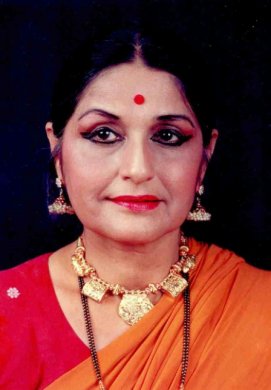 Kanak Rele came over to Kerala Kalamandalam mainly as a researcher to explore the history and aesthetics of Mohiniyattam through observation and analysis of the sources available. She did document the contributions of the surviving stalwarts in the field who were mostly confined to their practical knowledge. Of those whom Kanak Rele documented, she found the stylistics of Kunjukutty Amma far more appealing than those of the rest. Armed with the documented materials, Kanak Rele delved deep into the craft and content of Mohiniyattam. At the theoretical level, she garnered support from Hasthalakshanadeepika, a manual on the hand-gesture language widely in vogue as an indigenous text in Kerala, Sage Bharata's Natyasastra and Balaramabharatam of King Karthika Thirunal. With all these, she came out with her concept of body kinetics which became instrumental in providing a scientific temper and academic rigour to the art of Mohiniyattam. Academic pursuits With the establishment of the Nalanda Dance Research Centre in 1966 and Nalanda Nritya Kala Mahavidyalay in 1972 in Mumbai, Kanak Rele began to be recognized nationally and internationally as a high profile academic who could concretize a pedagogic framework for Mohiniyattam. Her academic endeavours in the field acquire greater significance viewed against the fact that the Faculty of Mohiniyattam at the Kerala Kalamandalam was inadvertently reluctant to and indifferent towards an academic advancement of the dance-form. Kalamandalam Kalyanikutty Amma, with whatever resources she had, did make an attempt to shed light on the history and growth of Mohiniyattam, categorize the adavus and add to the lyrics. Besides refurbishing the prevailing repertoire of Mohiniyattam, Kanak Rele doggedly undertook the task of further enriching its content for which her association with the renowned playwright, poet and theatre-director, the late Kavalam Narayana Panikkar proved highly resourceful. Panikkar was a belligerent votary of Sopana sangeetham, a style of singing of the Gita Govinda and other ancient devotional lyrics traditionally preserved by the temple castes, Marars and the Poduwals. One of the principal features of the Sopana style of music sung beside the sanctum-sanctorum of the Hindu temples in Kerala is its effective application of gamaka that goes very well in tune with the aandolana (undulations) instrumental to the movement dynamics of Mohiniyattam. Panikkar has vociferously questioned the dominance of Carnatic music in the dance form which he attributed to the undue influence exerted by the Tanjore Quartet, the court musicians of the 19th century ruler of Travancore, King Swathi Thirunal. Kanak Rele appreciated the rationale of Panikkar's arguments whole-heartedly. In her book, "Mohiniyattam: The Lyrical Dance" she has profusely quoted Panikkar by underscoring his contention that the Devadasi System was thrust on the Kerala region by cruel conspiracy of circumstances. Kanak Rele considers Mohiniyattam more as a social art than a temple art. Therefore it is inevitably oriented towards visual enchantment rather than bhakti. On stage 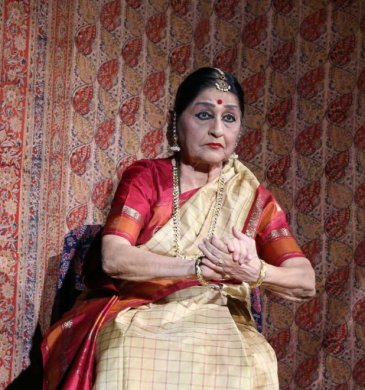 Sensing logic in the arguments of Panikkar, Kanak Rele distanced herself from the long prevalent format of classical Carnatic music followed by the vocalists of Mohiniyattam. Along with mridangam, maddalam too found a certain space in the recitals of Kanak Rele. Her background musicians and the one who wields the nattuvankam have been inextricably linked to Kathakali. Kanak Rele doubled down her vision of indigenising Mohiniyattam at one level by employing Kerala specific ragas and talas while upholding the margam authenticated by Hasthalakshanadeepika, the Natyasastra and the Balaramabharatam. Apart from the well-known compositions of Swathi Thirunal and Irayimman Thampi in Mohiniyattam, Kanak Rele's recitals include her own choreographies viz. Kubja, Kalyani, Silappadikaram and Swapnavasavadattam. I haven't had many opportunities to watch the recitals of Kanak Rele. Yet her performances created in me an impression that Mohiniyattam, in the techniques of presentation, can be legitimately more obliged to Kathakali than to Bharatanatyam. This is especially true as we come across the pattern of execution of the hand-gestures and facial expressions in the recitals of Kanak Rele and her immediate disciples. No doubt the chollus recited by the Nattuvan along with the vocal and instrumental music of her troupe has reinforced such an impression. Kanak Rele School of Mohiniyattam seems to have taken immense liberty in the treatment of the tempos pertaining to each and every tala used. I am neither willing nor competent to make a value judgement in regard to the reformations introduced by the doyenne. Grand felicitation 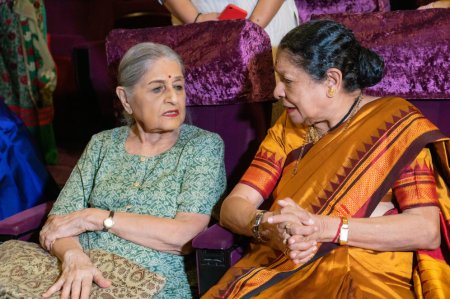 Dr.Kanak Rele with Darshana Jhaveri Kanak Rele turned 85 this year. Of her handful of talented disciples, Dr. Sunanda Nair is a class apart. This Houston based dancer is the flag-bearer of the baani armoured by her Guru. She recently organized in Mumbai a get together of fellow dancers, art enthusiasts and well-wishers to felicitate the octogenarian maestro. Preceding the felicitation the disciples of Sunanda presented a recital highlighting the essential characteristics of the techniques and the aesthetics of Mohiniyattam treasured by Kanak Rele. Deeply moved by the befitting tribute, she briefly recollected her intimacy with the dance form, the institution she set up and her interactions with the late Kavalam Narayana Panikkar. 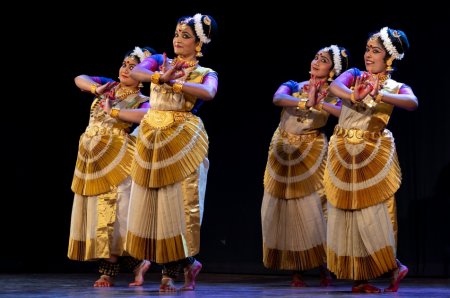 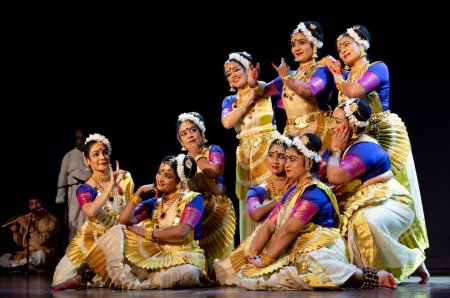 Disciples of Dr.Sunanda Nair As researcher, choreographer, educationist, performer and path-breaker, Kanak Rele's eventful life has for long been integral to the cultural and artistic life of the country. To her dear disciples and art lovers all over India and abroad Dr. Kanak Rele is the sum total of confidence, determination, knowledge and sensitivity. Gratifying it is to note that age has not withered any of these qualities ingrained in her personality. 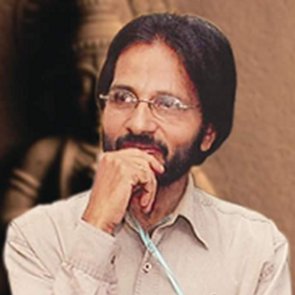 Former Deputy Registrar of Kerala Kalamandalam, V Kaladharan is also an art critic. He has published several articles at the academic level. 'From Meditative Learning to Impersonal Pedagogy' was published a couple of years back in an anthology 'Qui Parley' initiated and released by scholars and writers from the University of California, Berkeley. His articles on Indian performing arts and literature regularly appear in magazines and journals, and in the Friday Page of The Hindu. Post your comments Please provide your name and email id along with your comment. All appropriate comments posted with name and email id in the blog will also be featured in the site. |